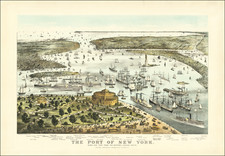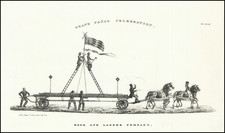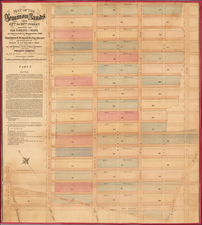The Birth of Mass Transit in New York Prophesized by the Man Who Gave the City Its Grid.
Large tinted lithograph with partial hand-coloring, published in New York City in 1848, illustrating John Randel Jr.'s proposal for an elevated mass transit system in lower Manhattan.
The view faces north up Broadway from Fulton Street. St. Paul's Chapel, The Astor House and other hotels, Smith's Segar Store, Genin Hatters, Barnum's Museum, and City Hall are all plainly seen.
The main focus of the lithograph is not on the street scene, interesting though it may be, but on Randel's plan for an elevated rail line running down Broadway. Randel's proposal is detailed, pragmatic, and somewhat involved. It called for railways elevated on 11-foot-high cast-iron columns, with "passenger cars moving in reverse directions propelled by Endless Ropes; operated by Stationary Steam Engines." The method for entering the passenger cars sounds somehow even less safe than the MTA platforms of today: "These cars do not stop to take in or let out passengers; this is accomplished by means of Tenders which move on another track alongside of & parallel to the main passenger track, and stop at the landings at about every second cross street."
A curious and unfortunately unbuilt luxury of Randel's plan is a "sofa elevator" rising from the street to a ladies' pavilion on each platform landing "for resting & meeting of friends who wish to ride in the same car".
The transverse section below the main view here illustrates and describes the construction of Randel's system, as well as a plan of underground chambers for water mains, gas mains, garbage pits, and sewer vaults. In total the view represents a panoply of cutting edge technology for the late-1840s: gas lamps, telegraph lines, automated sewer decontamination, etc. It provides a fascinating insight into the mind of one of America's greatest civil engineers.
Randel's scary-though-inventive design was never realized, and it was not until 1868 that the first New York City elevated rail line (The Ninth Avenue El) was opened to the public. This print thus stands out as one of the great examples of mass transit incunabula.
The view is very rare with only two copies located at New York City institutions (NYPL and MCNY). Before we purchased this example, it was last seen at auction in 1918.









![(New York - Long Island) Topographical Maps Long Island [Cover Title]](https://storage.googleapis.com/raremaps/img/small/88766.jpg)

![(Pocket Map) Colton's New York City, Brooklyn, Jersey City, Hoboken Etc [G. Woolworth Colton's New York City Jersey City, Hoboken, Brooklyn]](https://storage.googleapis.com/raremaps/img/small/85405.jpg)


![[Harlem]. Map of the Harlaem Commons surveyed agreeably to the boundaries established by the Commissioners appointed to settle the boundary lines between the common lands of the City of New York and the Town of Harlaem...](https://storage.googleapis.com/raremaps/img/small/59385.jpg)